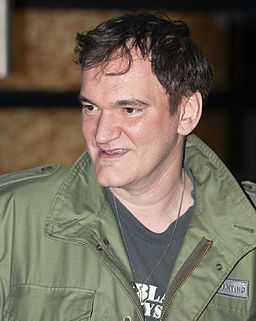1.Prologue: Interviewing a Cinephile’s Cinephile
Growing up in the 90s, an unsurprisingly high percentage of my friends had a poster of Quentin Tarantino’s Pulp Fiction hanging on the wall of their bedrooms. As someone who had a world map decorating his wall, the Pulp Fiction poster—designed to resemble the cover of a pulp fiction novel, with Uma Thurman laying on her stomach with her legs crossed behind her, cigarette in hand—seemed to me to be a hallmark of coolness.
In 90s America, specifically, a teenager like me living an unremarkable life of boredom in suburbia, Tarantino’s films were eye-opening. Scenes of the most mundane dialogue made interesting, punctuated with sudden bursts of striking violence; nostalgia as a thrill rather than a sentimental yearning; non-linear plot structure; an experimental indie spirit. Tarantino became synonymous with cool, and my friends and I would constantly quote his dialogue to each other.
In the fall of 2003, I was mere weeks into college life at UCLA when Kill Bill: Vol. 1 hit theaters. Like any good fanboy, I immediately went to my local theater in Westwood—a college town and the home of UCLA—to watch the film, and I still remember to this day the excitement I felt walking out of the experience. Kill Bill is a genre-bending mishmash of Tarantino’s influences—martial arts films, samurai films, blaxploitation, “macaroni" westerns, and Japanese anime. While the story is straightforward, the presentation is anything but. Tarantino has a reputation as a cinephile’s cinephile, and part of the charm of his work is that his films double as whirlwind tours of film theory and history.
Tarantino’s latest film, Once Upon a Time in Hollywood has several key scenes that take place in Westwood and along nearby Wilshire Boulevard. What’s more, 1969 Hollywood is brought to life not through CGI, but through the magic of cinema—having stores put up signs designed to evoke the era and bringing in over 2,000 vintage cars for the production. The director’s attention to detail shines through in every frame.
So, naturally, when I heard that I would have the chance to interview Tarantino about this film for Sekai e Hasshin! SNS Eigojutsu, the theme to Kill Bill (by Hotei Tomoyasu) immediately started playing in my head. All of the defining moments in your life require a score.
2.About Quentin Tarantino
Quentin Tarantino (1963-) is an American film director, screenwriter, and actor. Obsessed with Hollywood and films from a young age, he dropped out of high school around age 15 and took acting classes at a local theater company. In the 80s, he worked for a number of years at a video store in Manhattan Beach, and met a movie producer at a Hollywood party, who encouraged him to write a screenplay. He made his debut as a director and screenwriter with 1992’s Reservoir Dogs. His second feature, Pulp Fiction, won the Palme d’Or at the 1994 Cannes Film Festival, catapulting him to worldwide renown. He has stated that he intends to retire from directing after 10 films.
Reservoir Dogs
Tarantino directed, wrote, and acted in this, his feature-length debut. Despite being a heist film, the film does not depict the actual crime, and instead takes place before and after the failed heist. The film became a cult classic, and has been named by U.K. film magazine Empire as the greatest independent film of all time.
Pulp Fiction
Considered Tarantino’s masterpiece, this L.A. crime film is a fascinating contrast between monologues and mundane dialogue interspersed with sudden bouts of violence. It won numerous awards, including the Palme d’Or at the 1994 Cannes Film Festival.
Kill Bill
This revenge flick is brimming with Tarantino’s obsessive love for Japanese B movies. The climax of the first half takes place in a setting inspired by the izakaya Gonpachi in Nishi-Azabu, Tokyo—which became famous when former Prime Minister Koizumi took then-President Bush there for dinner—and guitarist Hotei Tomoyasu’s iconic “Battle Without Honor or Humanity” drives the soundtrack. Kill Bill was originally set to be released as a one film, but ended up being split into Vol. 1 and Vol. 2. Still, based on the fact that Once Upon a Time in Hollywood is being sold as Tarantino’s 9th film, the director apparently counts Kill Bill as one movie.
Inglourious Basterds
Tarantino’s World War II revisionist history film takes place in Nazi-occupied France, where a ragtag team of Jewish-American soldiers hunt down Nazis, and a young Jewish-French woman whose family was killed by an SS Colonel seeks revenge. The climactic scene, which takes place at the premiere of a Nazi propaganda film, is a one for the history books. The film was nominated for eight Academy Awards.
Once Upon a Time in Hollywood
Quentin Tarantino’s 9th film is a love letter to the city of L.A. and the Hollywood industry. Set in Hollywood in 1969, it follows a day in the life of fading actor Rick Dalton (Leonardo DiCaprio) and his longtime stunt double Cliff Booth (Brad Pitt). Margot Robbie is luminous as Sharon Tate, but looming over her and the rest of the film is the tragedy of her impending fate.
4.Getting Schooled
Before my one-on-one interview with Tarantino, I had the opportunity to attend the official Tokyo press event for the film. During the Q&A, when Tarantino was asked about what Hollywood meant to him, he answered by saying that the experience had been like attending high school for 20, 30 years. By that he meant that Hollywood is a fickle place where great success, medium success, medium failure, and great failure are all next to one another. Many of the people there are the same throughout the years, but fortunes and reputations shift constantly; over a certain period you could be really close to someone, but then distance may develop between you despite never really falling out. For Tarantino, his experience in Hollywood has been like the four years of high school stretched out over decades.
One more thing from the press event that struck me was when producer Shannon McIntosh talked about the pleasure of being on a Tarantino set. She said in-between filming the director gives cast and crew “film lessons", giving recommendations and talking about the industry’s rich history. She said that the cast and crew become like family, and whenever word gets out that Tarantino is working on a new film, people call her up asking when production might begin—they fully intend to plan their working schedules so that they can be a part of the next Tarantino joint.
In my one-on-one interview with Tarantino, he spoke passionately about not only his latest film, but about filmmaking in general. When I asked him why he continues to shoot on film in an age when digital has become the norm, he answered, “For me, movies are shot on film. That’s why they’re called ‘films’." Tarantino is also known for his preference for real props and sets, and his attention to lighting. He told me that film—and the theatrical experience—was the best medium for presenting those aspects in their full glory. And, he added, “Film just looks better."
When I asked him if he had any words of wisdom for aspiring filmmakers, he lamented that on the majority of movie sets today, the director sits behind a monitor—oftentimes in a separate room. He jokingly referred to such rooms as “Chair Town" or “Video Village", and explained that “Because in a situation like that, then that TV screen—that monitor—is directing the movie. You are not directing the movie." He stated in no uncertain terms his belief that the director should be right next to the camera, where he or she can hold the same vantage point and make his or her presence known to the actors. That way, the actors act not for the cameras or for some unseen audience in some faraway living room, but for the director.
Tarantino is known for his physically expressive demeanor, waving his large hands wildly as if conjuring movie magic right before your eyes. Each time he pointed at the camera during our interview, I got chills. And for a fleeting moment, it felt as if I was getting schooled on filmmaking.
5.My Wardrobe for This Interview
Black pinstripe suit by Tailor Fukuoka

I ordered what’s become my go-to style: three-roll-two jacket with side vents and single-pleated trousers with no belt loops, just long enough to touch my shoe uppers.
The super 110s count merino wool has a refined texture that under other circumstances probably could have cost me twice the price. (Super 110s refers to the grade of the wool—the higher the number, the thinner the threads. Super 110s count suits are durable and comfortable to wear.
Silver dotted necktie by Borrelli












